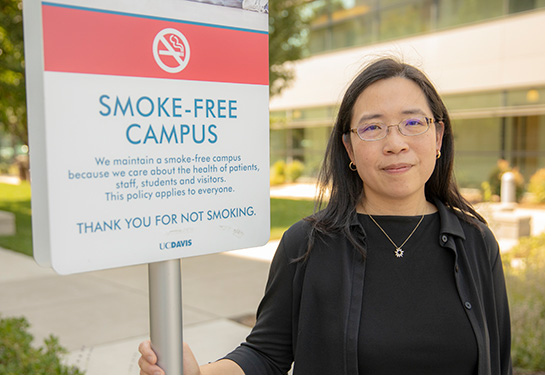Nearly half of the deaths from 12 cancers due to tobacco; higher than previously reported
UC Davis study shows Californians diagnosed with cancer have higher current tobacco use
Despite California’s success in reducing tobacco use, a new study published today in JAMA Network Open demonstrates the continued and significant burden tobacco inflicts on people with cancer.
The study was conducted by researchers at UC Davis Comprehensive Cancer Center who used data collected from the California Cancer Registry, a state-mandated population-based cancer surveillance system managed by UC Davis. The study looked at people diagnosed with one of 12 tobacco-related cancers from 2014-2019 in California. The analyses showed that close to half of the cancer deaths over two years, between 2017 – 2019 (totaling 93,764 Californians), were associated with tobacco use.
“This is almost double what was previously estimated in a study that looked at 2014 data,” said California Cancer Registry and UC Davis researcher Frances Maguire, who is the lead author of the study. “However, we believe this is a more accurate representation since tobacco use data came directly from individual patients with cancer rather than estimates based on general population surveys. This study is also specific to the 12 tobacco-related cancers.”
Tobacco status data used in the study included use of cigarettes, other smoked tobacco products (such as cigars and pipes) and smokeless tobacco products (such as chewing tobacco and snuff). The use of vaping products is not yet collected by the registry.
The study results showed that among the nearly 400,000 patients diagnosed with a tobacco-related cancer from 2014-2019, most were over 60 years old (72.3%). The majority (57.7%) were non-Hispanic white, were men (58%) and nearly half (46.6%) had lung or colorectal cancers.
Cancers most impacted by tobacco use
The greatest number of deaths attributable to tobacco, for both men and women, were from cancers of the lung and bladder. The greatest proportions of tobacco-related cancer deaths were found in the:
- lung (90.2%)
- larynx (85.6%)
- esophagus (58%)
- oral cavity/pharynx (55.5%)
- bladder (52.7%)
Men mostly had higher proportions of tobacco-related cancers compared with women, with the largest differences seen in:
- liver cancer (33.9% men, 11.1% women)
- stomach cancer (25.9% men, 6.5% women)
- kidney cancer (23.8% men, 6.8% women)
- acute myeloid leukemia (20.8% men, 3.0% women)
“Smoking remains the largest preventable cause of death from cancer and other diseases,” said UC Davis researcher Theresa Keegan, study co-author and co-principal investigator with the California Cancer Registry. “This study shows that tobacco continues to kill Californians with cancer at an alarming rate. Cancer registries can play an important role in monitoring progress for this priority population.”
Tobacco use trends
From 2014-2016 to 2017-2019, there was a decline in the proportion of deaths due to smoking from 48% to 45%, with larger declines for women compared with men. The overall number of smoking-attributed cancer deaths declined by approximately 10%.
“Our analyses of changes over the two time periods suggest promising trends in tobacco behavior among Californians newly diagnosed with cancer, which could be related to the state’s ongoing tobacco control efforts,” senior author of the study UC Davis Health internist and tobacco researcher Elisa Tong said.
In November 2016, a $2 per pack tobacco tax was passed by California voters that helps support the activities of the California Tobacco Control Program.
The overall tobacco quit ratio in the study, at 69.6%, is a little higher than the general population in California of 65.9%. There was also an increase in this ratio over the two time periods, which reflects improvement after the implementation of the state tobacco tax.
“Current tobacco use among the people diagnosed with cancer was higher than among the general population but decreased over time,” said Maguire. “This suggests that tobacco control efforts have contributed to a decline in cancer mortality in California, but smoking cessation efforts targeted at patients with cancer are needed.”
Over half (57.6%) of Californians in the cancer study had used tobacco at some point and current tobacco use was higher than the general population (17.5% vs. 11%), totaling 69,103 patients.
“What is important to note in the study findings is the number of Californians diagnosed with these 12 types of cancers that still use tobacco: about 1 in 5 men (19.6%) and 1 in 7 women (14.5%). Some people with lung cancer or laryngeal cancer had even higher use rates at 30-37%,” Tong said. “It’s important to remember that it’s never too late to quit smoking even after a cancer diagnosis because quitting can improve cancer treatment outcomes and significantly reduce mortality.”
Other authors of the study included Ani S. Movsisyan, Cyllene Morris, and Arti Parikh-Patel, with UC Davis Comprehensive Cancer Center.
UC Davis Comprehensive Cancer Center
UC Davis Comprehensive Cancer Center is the only National Cancer Institute-designated center serving the Central Valley and inland Northern California, a region of more than 6 million people. Its specialists provide compassionate, comprehensive care for more than 100,000 adults and children every year and access to more than 200 active clinical trials at any given time. Its innovative research program engages more than 240 scientists at UC Davis who work collaboratively to advance discovery of new tools to diagnose and treat cancer. Patients have access to leading-edge care, including immunotherapy and other targeted treatments. Its Office of Community Outreach and Engagement addresses disparities in cancer outcomes across diverse populations, and the cancer center provides comprehensive education and workforce development programs for the next generation of clinicians and scientists. For more information, visit cancer.ucdavis.edu.



